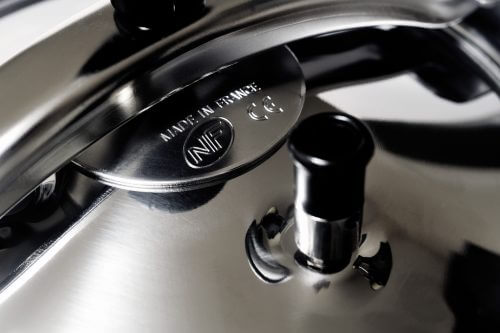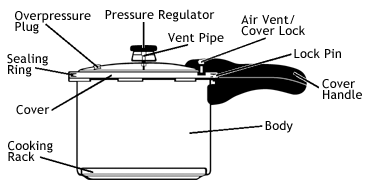Pressure cooker lids are one of the key factors behind pressurizing and depressurizing. It is the strongest component of the appliance that determines the quality of the brand. Pressure cooker lids consist of many parts that are used to build, maintain and release the pressure, and help to prepare food in several different manners.

In this post, you are going to learn how you can, and should, take care of the pressure cooker lid. But before that, it’s important to know what it’s usually comprised of.
Components of the Lid
- The Lid Handle: It has a locking mechanism; a slider or button which shuts with a click and secures the lid while cooking
- Gasket: It is used to seal the cooker in order to prevent steam leakage during pressure cooking
- Steam Vent and Pressure Regulator: The steam vent has the pressure regulator on the front side (the external surface of the lid) and is used to regulate and maintain internal pressure
- Pressure Indicator: A pin that shows the pressure level in the pan
- Over-pressure/Over-temperature Plug: A pressure release valve for releasing extra pressure during the pressure buildup and cooking phase
- Safety Fuse Plug: In old-style pressure cookers, there’s a special safety valve on the lid, made of metal alloy
- Pressure Gauge: It is not so common in cheaper models, but available in costlier models

Design Classifications
There are four different designs of the lid:
- Center Screw Design: It is attributed to vintage style pressure cookers that are still common. In this design, the lid is secured on top of the pot by means of a bar and a screw.
- Twist-on Design: It is one of the most common modern designs of pressure cookers, in which the lid is placed on top of the pot and twisted approximately 30 degrees to lock itself. This design has flanges engaged with the lid.
- Internal Lid Design: This design consists of an oval lid which is placed inside at an angle. There is a spring arrangement that is used for holding the lid on the opening until the pressure is reached. The lid is larger than the pot opening and it needs to be turned so that it can align itself with the opening of the pot.
- Bolt-down Design: In this design, there are flanges on the lid as well as on the body. The lid is locked by passing the bolt through these flanges and pignuts are used to lock them. This design is typically used in pressure canners.
How to Wash the Lid
In general, it is restricted to wash pressure cooker lids in a dishwasher. If you have a second generation model that has a new valve system, then do not leave the lid to soak in water. Mentioned below are few “do’s and don’ts” of washing pressure cooker lids:
- Don’t wash the whole appliance at the same time. Irrespective of the model or make, lids must be washed separately, by hand.
- Remove all the removable parts, such as the pressure weight, the gasket, and others, before washing the lid. Wash all the components separately, using hot water.
- While washing the lid, be careful about the vent pipe and locking flanges (if attached to the lid).
- Use hot water and dishwashing soap to wash the lid.
- You may use a non-metal scrubber or sponge, if necessary. Check the user’s manual to see if you can use these items.
- Don’t use abrasive cleaners of any sort.
- For stubborn stains, you can use non-abrasive cleaners such as Bon Ami.
- You can polish the outer surface with Bar Keepers Friend
- The pressure regulator weight cannot be cleaned by hand. Use a small brush ( a baby-sized toothbrush will be effective) to clean it from inside.
- The valve system must be properly cleaned. Remove every food particle around it.
- Pay attention to the sealing surface and remove the food residue from there.
- After washing all the parts, make sure each of them is dried completely.
- After washing and drying, fix all the components back to their original places and ensure they’re properly fixed. For example, the valve stem should function vertically without any trouble, and the vent pipe should have no residue or water left inside.
How to Clean Old-Style Vent Pipes
If you have a vintage pressure cooker, the vent pipe must have been attached to the lid. It must be cleaned after every use because the steam always leaves a mineral deposit on the internal walls of the pipe.
You can see a thin blackish layer of deposits inside the vent pipe. This will build up after every use of the appliance and cause functional issues in your cooker.
Even if the vent pipe appears to be clean, it must have a very thin layer of mineral deposit that can only be removed with proper cleaning. To clean the internal walls of the vent pipe, use a pipe cleaner.
Safety Plug
Depending upon the model and make, there are two main types of safety plugs:
#1. Safety Fuse Plug
- For Modern Pressure Cookers: An over temperature pressure plug or fuse plug is used in modern pressure cookers. Although it’s more efficient than the fuse plug used in old-style cookers, your pressure cooker will not function properly if this safety plug melts down. Replacement of the plug is necessary before using the pressure cooker again.
- For Old Style Pressure Cookers: There is a safety fuse plug on the lid. Made with a metal alloy, it is sensitive to excessive heat and melts when dangerously overheated. As a result, the hole appears on the lid which directs the excess pressure to the vent.
#2. Over-pressure Plug
In old appliances, this is another safety feature available on the lid for releasing pressure. The over-pressure plug is generally made of rubber. Also included is a tiny metal valve stem that moves up and allows the plug to seal upon pressure buildup. For proper maintenance, make sure that both the rubber and the metal, work properly.
Conclusion
The pressure cooker lid is very important as it consists of all the important components that create a strong seal to secure the steam inside the cooker, then release it safely out of the system through the vent pipe and pressure release valve. Each component needs to be properly cleaned and well-maintained, otherwise your pressure cooker will have functional issues. Inspect each and every part of the lid and replace removable parts periodically to keep your pressure cooker in good condition.
Useful post for all
I lost the overpressure rubber plug plus its metal. The pressure leaks continously. What could I use instead to seal it.
Depending on your model you may be able to find a replacement on amazon. Otherwise, I recommend you contact the manufacturer for support.
Thanks
I wonder if power washing could clean your pressure cooker.